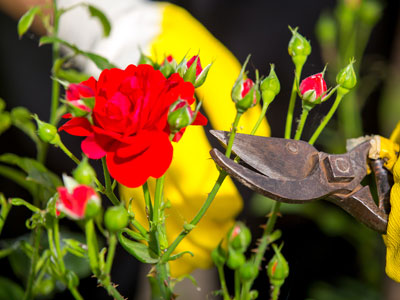Roses are some of the most beautiful plants in the world. There are many varieties blooming in different colors and sizes. These plants will bloom from spring until autumn with the correct care.
Keeping these plants healthy and blooming does take a bit of time for the gardener. The effort is worth the work as the roses will continue to produce blooms throughout their entire season with the correct care. Knockout roses will produce blooms every five or six weeks from mid-spring to autumn if deadheaded.
Why Deadhead
When a rose fades after it blooms and dies this is called a deadhead bloom. This is common to all plants with flowers; however, roses bloom more than most plants and this happens quite often. Taking these dead blooms off the rose plant will keep the plant neat and looking well kept. Taking off the dead blooms or deadheading a gardener will make it easier for the plant to bloom more often and producer larger roses.
Preparing To Cut
When preparing to cut make sure the shears are sharp. Dull shears will make this job more difficult. It may also damage the plant itself by leaving torn and ragged ends where the cut is made. Make sure heavy gardening gloves are worn. These heavy gloves are used to avoid being scratched by thorns. Leather gloves may also be used for this purpose. If reaching into the plant or above the head it is recommended to wear a heavier shirt to avoid scratches to the arms.
Cleaning The Shears
Mix one part bleach to ten parts water in a bucket to make a sanitizing wash for the shears. Rinse the shears before every cut by placing them in the bucket, then open and close the shears several times. The shears do not need to be dried before cutting. Many rose plants may have fungus growing on them. Some plants will develop bacterial fungus as well. Using this solution will assist with not spreading the fungus or other plant ailments to more plants.
Cutting The Blooms
When cutting the blooms it is best to locate the cut a half inch to an inch above the strongest buds. The bud is where the new branches will emerge. Cut at a 45-degree angle away from the bud.
Cutting away from the bud means cutting with the short angle closest to the new branch which is forming.

Disposing Of Blooms
Once the roses are cut they may be disposed of by placing them in a trash bag for curbside pickup. If it is easier they may also be burned as there are no seeds to worry about spreading from deadhead roses.
Growing plants need food, watering and care. Deadheading is a normal part of this cycle in order to grow beautiful, larger blooms on rose plants. Deadheading knockout roses will keep the plants looking neat. This will enhance the overall look of the plant itself while maintaining its place within a garden setting. Deadheading the blooms will also force the plant to bloom more frequently. The blooms will be larger when the plant is properly deadheaded.
Related Articles




